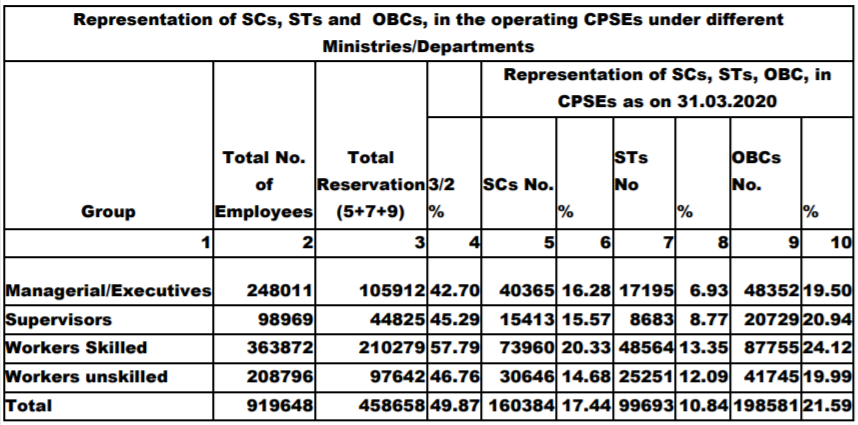Reservation : Recruitment in PSUs
GOVERNMENT OF INDIA
MINISTRY OF CORPORATE AFFAIRS
LOK SABHA
UN-STARRED QUESTION NO. 2221
ANSWERED ON MONDAY, MARCH 8, 2021/PHALGUNA 17, 1942 (SAKA)
RECRUITMENTS IN PSUs
QUESTION
2221. SHRI GANESH SINGH:
Will the Minister of CORPORATE AFFAIRS be pleased to state:
(a) the details of the total appointments made during the period from 08.09.1993 to 31.12.2020 in the Public Sector Undertakings (PSU), banks and insurance companies/financial institutions with 51 per cent Government stake along with the details of backlog posts PSU-wise, bank-wise, insurance company-wise, financial institution-wise, post-wise and category-wise ;
(b) whether reservation rules are applicable to all the various PSUs/financial institutions in which Government stake is 51 per cent or more;
(c) if so, the details thereof;
(d) whether reservation rules apply to PSUs/financial institutions having 50 per cent Government stake;
(e) if not, the details of the order issued by the Government in this regard;
(f) whether 27 per cent reservation policy for OBC has not been implemented in many PSUs/Banks/insurance companies/financial institutions etc till date inspite of having 51 per cent or more than 51 per cent Government stake; and
(g) if so, the corrective steps taken by the Government in this regard?
ANSWER
THE MINISTER OF STATE FOR FINANCE AND CORPORATE AFFAIRS (SHRI ANURAG SINGH THAKUR)
(a) to (g): The Ministry of Corporate Affairs administers Companies Act, 2013 (the Act), Limited Liability Partnership Act, 2008, Insolvency & Bankruptcy Code, 2016.
However, the Ministry of Heavy Industries and Public Enterprises, Department of Public Enterprises and Public Enterprises Selection Board (PESB), Department of Personnel and Training (DoPT) have informed as under:
I. Ministry of Heavy Industries and Public Enterprises, Department of Public Enterprises has informed that Public Sector Undertakings (PSUs) is a wider definition and includes all central organizations including banks, insurance companies, Central Public Sector Enterprises (CPSEs) and other autonomous organizations of Central Government. Department of Public Enterprises (DPE) is a nodal coordinating Department for CPSEs only excluding banks and other financial institutions & autonomous organizations. CPSEs, banks and other financial institutions function under the administrative control of their respective Ministry/ Department. DPE collect limited information in respect of CPSEs only. The information available in respect of CPSEs is as follows:
As on 31-03-2020, the 366 CPSEs has employed 14.18 lakhs persons. The category wise detail is as follows:
| Sl. No. | Category | No. of employees as on 31.03.2020 |
| 1 | Managerial/Executives | 2,49,320 |
| 2 | Supervisory | 99,077 |
| 3 | Non-Executives | 5,73,479 |
| 4 | Contract Workers / Employees / Casual/ Daily Rated Workers | 4,95,751 |
| Total | 14,17,627 |
The provisions relating to reservation formulated by the nodal department i.e. DoPT stand mutatis mutandis extended to CPSEs also. As per the information available with DPE, the representation of SC, ST & OBCs in the operational CPSEs in respect of regular employees as on 31.03.2020 is given below:

II. Public Enterprises Selection Board (PESB), Department of Personnel and Training has informed that PESB is responsible for making selection/ recommendation of candidates for Board level posts in CPSEs. Subsequent, appointments of the recommended candidates are made by the Ministry/Department concerned under the procedure laid down.
As per the extant policy of the Government, there is no reservation applicable to Board level posts in CPSEs. Accordingly, the PESB, while inviting applications for filling up Board level vacancies, does not seek for information related to the category of the candidate to which he or she belongs.
[download id=”113180″ template=”dlm-buttons-button”]
Leave a Reply